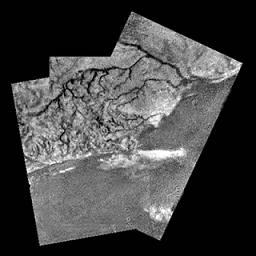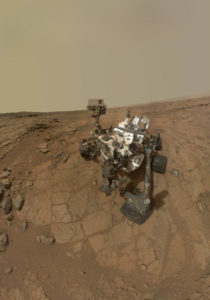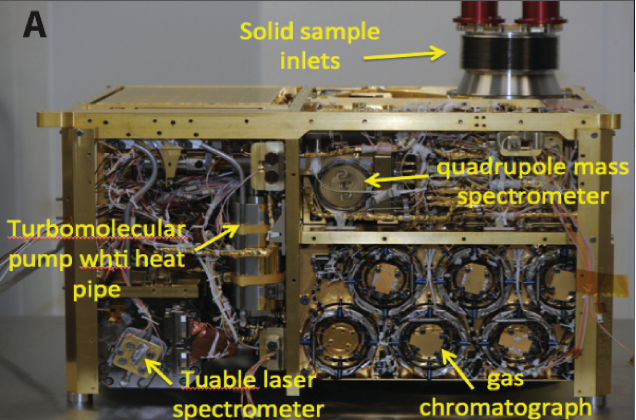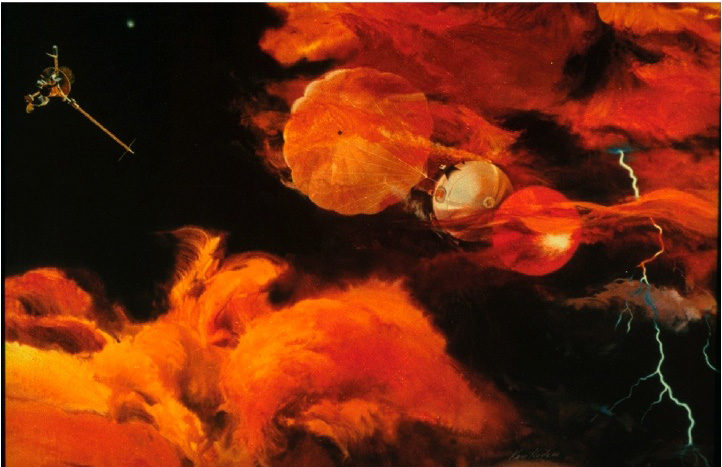Origin and evolution of planetary and satellite atmospheres, and the formation of giant planets, is one of the main areas of research in the Planetary Science Laboratory. To achieve this ambitious goal, studies of physical, chemical, meteorological, and astrobiological processes of planets and satellites with atmospheres are being carried out. The focus of our current research is especially on the giant planets, Titan, Mars, Venus, and the extrasolar planets. Numerical modeling, and analysis and interpretation of data from observations with spacecraft, satellites and from the ground are being done. Ready access to critical observational data sets has been possible due to the participation of several PSL members on the teams of current, past, and future planetary missions.
Current solar system exploration projects include Sample Analysis at Mars (SAM) with GCMS and Tunable Laser Spectrometer on the Mars Science Laboratory (Atreya), Cassini-Huygens Gas Chromatograph Mass Spectrometer (GCMS) and the Aerosol Collector Pyrolyzer (ACP) investigations (Atreya), Juno-Jupiter Polar Orbiter (Atreya), Planetary Fourier Spectrometer (PFS) on the Mars Express and Venus Express missions (Atreya), and Meteorology packages on MSL and Phoenix Mars Polar Lander (Renno). Some highlights of our findings are given below.
Publications: Please click on the websites of PSL scientists under PEOPLE to find their publications.
TITAN: Earth-like moon of Saturn
With the GCMS on the Cassini-Huygens entry probe we discovered that in Titan’s meteorology, methane plays a role similar to water in hydrological cycle on Earth. Titan’s “methalogical” cycle also appears to be seasonal. The very existence of a nitrogen atmosphere depends on the complex photochemical processes of methane. However, the same processes destroy methane irreversibly in tens of million years. In the absence of the warming due to methane-derived hydrocarbon hazes and the collision-induced opacity, nitrogen would gradually condense, leading to a substantially reduced atmosphere. Thus the methane in the atmosphere will need periodic or episodic replenishment, perhaps from re-charging of hydrocarbon lakes from underground storage of methane as clathrates. The origin of methane is controversial. We conjecture a likelihood of hydrogeochemical process – serpentinization – in Titan’s interior as well as direct capture of methane during Titan’s accretion. Nitrogen, on the other hand, could not have been brought in as N2, but formed from dissociation of nitrogen-bearing molecules, such as ammonia. The process was examined quantitatively by Atreya et al. (Science, 201, 611, 1978) before Voyager actually discovered the nitrogen atmosphere of Titan. The hypothesis got a boost from the Huygens GCMS measurements. Click to see movie of Huygens descent to the surface of Titan. Movie and image courtesy of University of Arizona/ESA/NASA .
MARS – Trace Constituents, Methane, Organics, Life Habitability (Mars Science Laboratory, Mars Express)
The detection of methane on Mars in 2004 by the Planetary Fourier Spectrometer on Mars Express orbiter and by two ground-based telescopes led to renewed interest in the search for extinct or extant life on Mars, since life as we know it produces methane (90-95% of the methane on earth is ultimately biological in origin). However, the data on methane on Mars from above observations have been controversial.
The Sample Analysis at Mars (SAM) suite of instruments on Curiosity Rover of the Mars Science Laboratory (MSL) carries a tunable laser spectrometer (TLS), which is capable of detecting parts per billion levels of methane with high precision. When coupled with the quadrupole mass spectrometer (QMS) of SAM suite, the detection capability increases by at least an order of magnitude. The measurements to date show no definitive presence of methane at Curiosity’s Gale Crater landing site. The upper limit is very low, so that if methane is present at these low levels it could arise from any of the potential sources that include water-rock reactions, degradation of surface organic matter by solar UV or relatively low levels of methanogenesis. SAM will continue to look for any seasonal, diurnal or sporadic variations in methane.
Methane is just one of many scientific pursuits of SAM. SAM is measuring the composition of the atmosphere and volatiles trapped in the soil and rocks of Mars. The high precision isotope measurements of CO2 and H2O in the air, soil and from inside rocks by SAM will reveal the history of Mars climate evolution and surface-atmosphere interactions. The SAM gas chromatograph mass spectrometer data on volatiles released from solid samples will complement the isotope data, and reveal the presence of any organics. No evidence of surface organics has been found in remote sensing observations. Their absence from the Martian surface has been suggested as being due to their degradation by surface oxidants including hydrogen peroxide and perchlorates or their products, and by the solar UV and cosmic rays. The SAM suite measurements over the course of Curiosity’s mission together with complementary data on mineralogy and geology from other MSL instruments are expected to provide the required information for meaningfully addressing the age old question: did Mars ever have a habitable environment for microbial life.
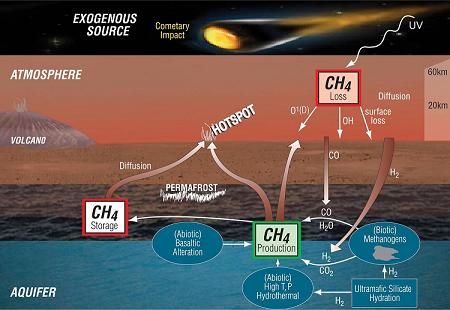
The Giant Planets (Cassini-Huygens, Juno, Galileo)
Our focus of research here is on the formation of the gas and icy giant planets and their atmospheres. Our approach is to determine and compare the heavy element composition and meteorology in well-mixed atmospheres, as comparative planetology of well-mixed atmospheres of the outer planets is key to the origin and evolution of the solar system, and, by extension, of extrasolar systems. Abundance of the heavy elements is essential for constraining the planetary formation models. This means probing to levels well-below the clouds, at least in the case of gas giants. Galileo Probe was the only probe that ever sampled the atmosphere of a giant planet in situ. The findings of the Galileo Probe Mass Spectrometer were surprising, in that the abundance of heavy elements, C, N, S, Ar, Kr, and Xe relative to hydrogen, on Jupiter were found to be 2-6 times their respective solar values (based on current solar elemental abundances). However, the Probe failed to measure the abundance of water in well-mixed atmosphere, hence the oxygen elemental ratio, since it entered a 5 micron hot spot – the Sahara Desert of Jupiter. The determination of water abundance in well-mixed atmosphere is critical, as water was presumably the original carrier of heavy elements to Jupiter (and most likely, to all outer planets). The current elemental abundances are illustrated below, and represent an update of S. K. Atreya and A. S. Wong, Space Sci. Rev., 116, Nos. 1-2, pp 121-136, 2005; S. K. Atreya, et al., Planet. Space Sci.; and 51, 105, 2003; and T. C. Owen, et al., Nature, 402, 269, 1999.
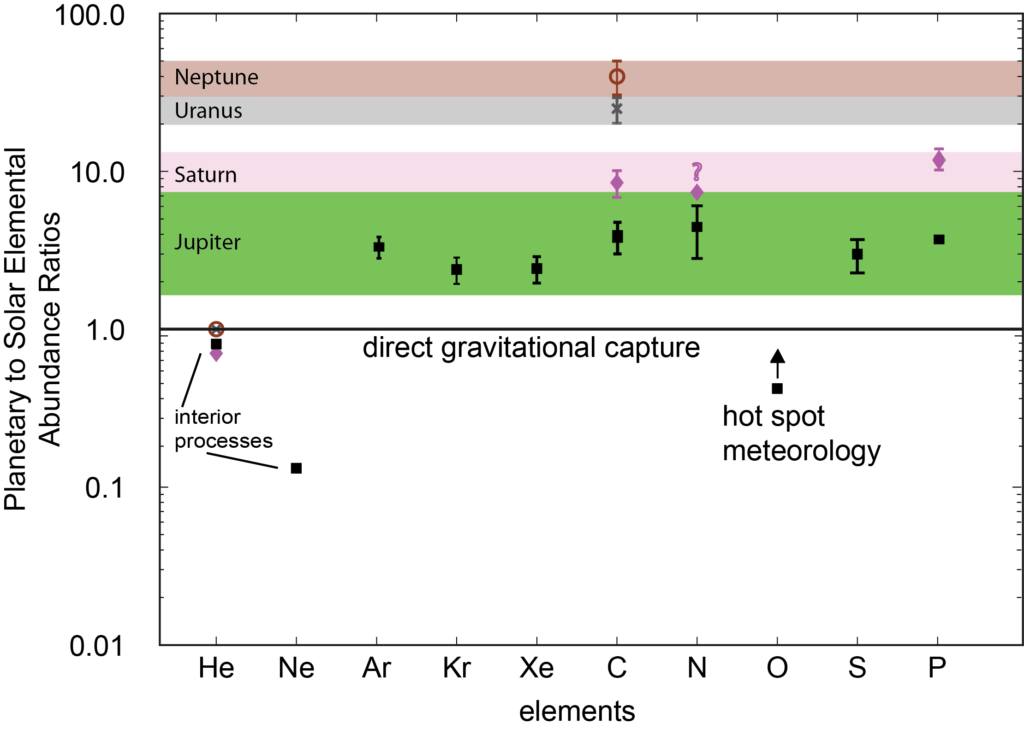
We expect to settle the question of the abundance of water in Jupiter’s well-mixed atmosphere with microwave radiometer measurements on Juno – Jupiter Polar Orbitar. Juno was launched in August 2011 and will arrive at Jupiter five years later in July 2016. In the meantime we continue to further develop models of giant planet formation and the origin of their atmospheres, by analyzing the latest measurements of elemental and isotopic abundances in all outer planets from Earth and space, and then constraining the models with the results.
Future
The answers to big questions of the formation of solar systems and of the atmospheres within them would require determination of elemental abundances in the atmospheres of all four giant planets. Entry probes are essential for this. The technological challenges of entry, data transmission and extreme thermal and pressure environments are daunting. We are developing science drivers and mission concepts of future probe missions to the outer planets, so that enabling technologies could be identified and worked on to retire risk early on.

